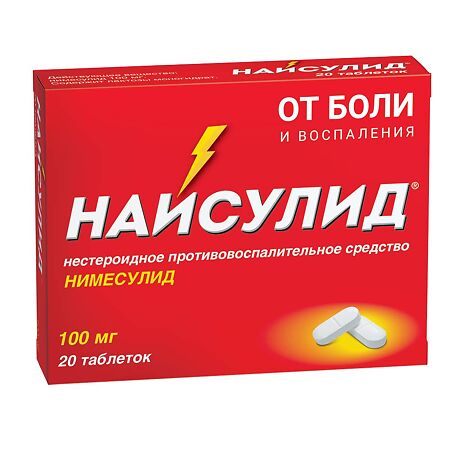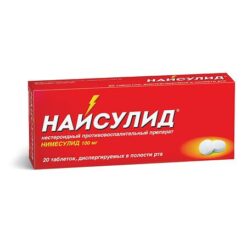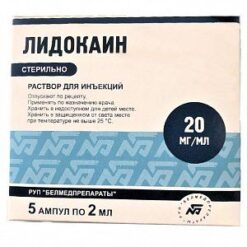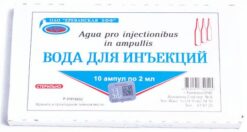No products in the cart.
Naisulide, tablets 100 mg 20 pcs
€7.24 €6.34
EAN: 4605077012138
SKU: 506786
Categories: Anesthesia and resuscitation, Local anesthetics, Medicine
Description
Pharmacotherapeutic group
NSAIDs
ATX code: M01AX
Pharmacodynamics:
Nimesulide is a nonsteroidal anti-inflammatory drug (NSAID) of the sulfonamide class. It has anti-inflammatory analgesic and antipyretic effects. Nimesulide belongs to new generation of NSAIDs which mechanism of action is related to selective inhibition of cyclooxygenase II and influence on several other factors: inhibition of platelet-activating factor of tumor necrosis factor alpha, inhibition of proteinases and histamine.
Pharmacokinetics:
Intake
After oral administration is well absorbed from the gastrointestinal tract (GIT). Maximum plasma concentration (Cmax) after oral administration is reached on average after 2-3 hours.
Distribution
Binding with plasma proteins – 95% with erythrocytes – 2% with lipoproteins – 1% with acidic alpha1-glycoproteins – 1%. It penetrates into the tissues of the female genitalia where after a single administration its concentration is about 40% of the blood plasma concentration. It penetrates well into the acidic environment of the inflammation focus (40%) and synovial fluid (43%). Easily penetrates through histohematic barriers.
Metabolism
Metabolized in the liver by the cytochrome P450 isoenzyme (CYP)2C9. The main metabolite is pharmacologically active parahydroxy derivative of nimesulide – hydroxynimesulide.
Elimination
The half-life of nimesulide (T1/2) is about 156-495 hours for hydroxinesulide – 289-478 hours.
Nimesulide is excreted mainly through the kidneys (about 50% of the dose taken) hydroxinesulide is excreted through the kidneys (65%) and with the bile (35%) undergoes enterohepatic recirculation.
Pharmacokinetics in special groups of patients
In patients with mild to moderate renal insufficiency (creatinine clearance 30-80 ml/min) and in children and elderly persons the pharmacokinetic profile of nimesulide does not change significantly.
Repeated use does not lead to cumulation of the drug.
Indications
Indications
Rheumatoid arthritis articular syndrome with exacerbation of gout; psoriatic arthritis; ankylosing spondylitis; osteochondrosis with radicular syndrome; osteoarthritis; myalgia of rheumatic and non-rheumatic origin; inflammation of tendon ligaments, bursitis, including post-traumatic inflammation of soft tissues; pain syndrome of various origins (including in the postoperative period with injuries, algodismenorrhea, toothache, headache, arthralgia, lumbar ischialgia).
The drug is intended for symptomatic therapy to reduce pain and inflammation at the time of use and does not affect the progression of the disease.
Pharmacological effect
Pharmacological effect
Pharmacotherapeutic group
NSAIDs
ATX code: M01AX
Pharmacodynamics:
Nimesulide is a non-steroidal anti-inflammatory drug (NSAID) from the sulfonamide class. Has anti-inflammatory analgesic and antipyretic effects. Nimesulide belongs to a new generation of NSAIDs, the mechanism of action of which is associated with selective inhibition of cyclooxygenase II and the effect on a number of other factors: suppression of platelet activating factor, tumor necrosis factor alpha, suppression of proteinases and histamine.
Pharmacokinetics:
Suction
After oral administration, it is well absorbed from the gastrointestinal tract (GIT). The maximum concentration in blood plasma (Cmax) after oral administration is achieved on average after 2-3 hours.
Distribution
Communication with blood plasma proteins – 95% with erythrocytes – 2% with lipoproteins – 1% with acidic alpha1-glycoproteins – 1%. Penetrates into the tissues of the female genital organs, where after a single dose its concentration is about 40% of the concentration in the blood plasma. Penetrates well into the acidic environment of the inflammation site (40%) and synovial fluid (43%). Easily penetrates histohematic barriers.
Metabolism
Metabolized in the liver using the cytochrome P450 (CYP)2C9 isoenzyme. The main metabolite is the pharmacologically active parahydroxy derivative of nimesulide – hydroxynimesulide.
Removal
The half-life of nimesulide (T1/2) is about 156-495 hours; hydroxynemesulide is 289-478 hours.
Nimesulide is excreted from the body mainly through the kidneys (about 50% of the dose taken); hydroxynimesulide is excreted through the kidneys (65%) and undergoes enterohepatic recirculation with bile (35%).
Pharmacokinetics in special groups of patients
In patients with mild to moderate renal failure (creatinine clearance 30-80 ml/min), as well as in children and the elderly, the pharmacokinetic profile of nimesulide does not change significantly.
Repeated use does not lead to accumulation of the drug.
Special instructions
Special instructions
The drug should be used with caution in patients with a history of gastrointestinal diseases (ulcerative colitis, Crohn’s disease) since exacerbation of these diseases is possible.
The risk of gastrointestinal bleeding, ulcer/perforation of the stomach or duodenum increases with increasing doses of NSAIDs in patients with a history of gastric or duodenal ulcers, especially complicated by bleeding or perforation, as well as in elderly patients; therefore, treatment should begin with the lowest possible dose.
Patients receiving medications that reduce blood clotting or inhibit platelet aggregation also increase the risk of gastrointestinal bleeding. If gastrointestinal bleeding or gastric ulcers occur in patients taking Naisulide®, treatment should be discontinued.
If symptoms similar to signs of liver damage appear (anorexia, itching, yellowing of the skin, nausea, vomiting, abdominal pain, darkening of urine, increased activity of liver transaminases), you should immediately stop using the drug and consult a doctor.
In patients with arterial hypertension, cardiac dysfunction, and cerebrovascular diseases, the drug should be used with caution. If the condition worsens, treatment with the drug must be stopped.
Since nimesulide is partially excreted by the kidneys, its dose for patients with impaired renal function should be reduced depending on creatinine clearance. If renal function deteriorates, the drug should be discontinued.
Nimesulide can change the properties of platelets, so caution must be exercised when using the drug in people with hemorrhagic diathesis; however, the drug does not replace the preventive effect of acetylsalicylic acid in cardiovascular diseases.
During treatment with Naisulide®, it is recommended to avoid the simultaneous use of hepatotoxic drugs, analgesics, other NSAIDs (with the exception of low doses of acetylsalicylic acid used in antiplatelet doses) and the use of ethanol.
In patients taking nimesulide together with cardiac doses of acetylsalicylic acid, combination therapy should be used together with gastroprotectors (proton pump inhibitors or misoprostol).
Elderly patients are especially susceptible to adverse reactions to NSAIDs, including the risk of life-threatening gastrointestinal bleeding and perforation, decreased renal function, liver and heart. When taking the drug for this category of patients, proper clinical monitoring of the condition of these patients is necessary.
Given reports of visual impairment in patients taking other NSAIDs, if any visual impairment occurs, the use of Naisulide should be immediately discontinued and an ophthalmological examination performed.
Impact on the ability to drive vehicles. Wed and fur.:
The effect of the drug on the ability to drive vehicles and machinery has not been studied; therefore, during the period of use of the drug, caution should be exercised when driving vehicles and engaging in potentially hazardous activities that require increased concentration and speed of psychomotor reactions.
Active ingredient
Active ingredient
Nimesulide
Composition
Composition
1 tablet contains:
active ingredient: nimesulide 100 mg;
excipients: microcrystalline cellulose, lactose monohydrate, potato starch, povidone K-30, sodium carboxymethyl starch (sodium starch glycolate), talc, magnesium stearate.
Pregnancy
Pregnancy
The use of nimesulide during pregnancy and breastfeeding is contraindicated.
If it is necessary to use nimesulide during breastfeeding, breastfeeding should be discontinued.
The use of nimesulide may adversely affect female fertility and is not recommended for women planning pregnancy. When planning a pregnancy, consultation with your doctor is necessary.
Contraindications
Contraindications
– Hypersensitivity to nimesulide or other components of the drug;
– complete or incomplete combination of bronchial asthma, recurrent polyposis of the nose or paranasal sinuses and intolerance to acetylsalicylic acid and other NSAIDs (including a history);
– anamnestic data on the development of hepatotoxic reactions when using nimesulide preparations;
– simultaneous use with other drugs with potential hepatotoxicity;
– inflammatory bowel diseases (Crohn’s disease and ulcerative colitis) in the acute phase;
– the period after coronary artery bypass surgery;
– erosive and ulcerative changes in the mucous membrane of the stomach and duodenum; active gastrointestinal bleeding;
– history of cerebrovascular bleeding;
– hemophilia and other bleeding disorders;
– decompensated heart failure;
– severe renal failure (creatinine clearance <30 ml/min), progressive kidney disease, confirmed hyperkalemia;
– liver failure or any active liver disease;
– alcoholism and drug addiction;
– lactase deficiency, lactose intolerance, glucose-galactose malabsorption;
– pregnancy and breastfeeding;
– children’s age up to 12 years.
With caution:
Arterial hypertension diabetes mellitus compensated heart failure coronary heart disease cerebrovascular diseases dyslipidemia/hyperlipidemia peripheral arterial disease smoking frequent alcohol consumption renal failure (creatinine clearance 30-60 ml/min).
History of ulcerative lesions of the gastrointestinal tract; presence of Helicobacter pylori; old age; long-term previous use of NSAIDs; severe somatic diseases.
Concomitant therapy with the following drugs: anticoagulants (for example warfarin) antiplatelet agents (for example acetylsalicylic acid clopidogrel) oral glucocorticosteroids (for example prednisolone) selective serotonin reuptake inhibitors (for example citalopram fluoxetine paroxetine sertraline).
Side Effects
Side Effects
WHO classification of the incidence of side effects:
Very common (≥1/10) common (≥1/100 < 1/10) uncommon (≥1/1000 < 1/100) rare (≥1/10000 < 1/1000) very rare (< 1/10000) including individual messages.
Blood and lymphatic system disorders
Rarely: anemia, eosinophilia, hemorrhage;
Very rare: thrombocytopenia, agranulocytosis, pancytopenia purpura, thrombocytopenic prolongation of bleeding time.
Immune system disorders
Rarely: hypersensitivity reactions;
Very rare: anaphylactoid reactions.
Skin and subcutaneous tissue disorders
Uncommon: skin itching, skin rash, increased sweating;
Rarely: erythema dermatitis;
Very rare: urticaria, angioedema, facial edema, erythema multiforme, Stevens-Johnson syndrome, toxic epidermal necrolysis (Lyell’s syndrome).
Nervous system disorders
Uncommon: dizziness;
Very rare: headache, drowsiness, encephalopathy (Reye’s syndrome).
Mental disorders
Rarely: feeling of fear, nervousness, nighttime “nightmare” dreams.
Sensory disorders
Rare: blurred vision.
Cardiovascular disorders
Uncommon: increased blood pressure;
Rarely: tachycardia, lability of blood pressure, “hot flashes”, palpitations.
Respiratory system disorders
Uncommon: shortness of breath;
Very rare: exacerbation of bronchial asthma, bronchospasm.
Gastrointestinal disorders
Common: diarrhea nausea vomiting;
Uncommon: constipation, flatulence, gastritis;
Very rare: abdominal pain dyspepsia stomatitis tarry stools gastrointestinal bleeding ulcer and/or perforation of the stomach or duodenum.
Disorders of the liver and biliary tract
Often: increased activity of liver enzymes;
Very rare: hepatitis, fulminant hepatitis, jaundice, cholestasis.
Renal and urinary tract disorders
Rarely: dysuria, hematuria, urinary retention;
Very rare: renal failure, oliguria, interstitial nephritis.
Disorders of water-electrolyte metabolism
Rarely: hyperkalemia.
Others
Uncommon: peripheral edema;
Rarely: asthenia;
Very rare: hypothermia.
Interaction
Interaction
Glucocorticosteroids increase the risk of gastrointestinal ulcers or bleeding.
Antiplatelet agents and selective serotonin reuptake inhibitors (SSRIs) increase the risk of gastrointestinal bleeding.
Anticoagulants
NSAIDs may enhance the effect of anticoagulants such as warfarin. Due to the increased risk of bleeding, this combination is not recommended and is contraindicated in patients with severe coagulation disorders. If combination therapy cannot be avoided, careful monitoring of blood clotting parameters is necessary.
Diuretics
NSAIDs may reduce the effect of diuretics. In healthy volunteers, nimesulide temporarily reduces the excretion of sodium under the influence of furosemide, to a lesser extent – the excretion of potassium and reduces the actual diuretic effect. The simultaneous use of nimesulide and furosemide leads to a decrease (by approximately 20%) in the area under the concentration-time curve (AUC) and a decrease in the cumulative excretion of furosemide without changing the renal clearance of furosemide. The simultaneous use of furosemide and nimesulide requires caution in patients with renal or heart failure.
ACE inhibitors and angiotensin II receptor antagonists
NSAIDs may reduce the effect of antihypertensive drugs. In patients with mild to moderate renal failure (creatinine clearance 30-80 ml/min), with simultaneous use of ACE inhibitors, angiotensin II receptor antagonists and drugs that suppress the cyclooxygenase system (NSAID antiplatelet agents), further deterioration of renal function and the occurrence of acute renal failure, which is usually reversible, is possible. These interactions should be taken into account in patients taking nimesulide in combination with ACE inhibitors or angiotensin II receptor antagonists.
This combination of drugs should be prescribed with caution, especially in elderly patients. Patients should receive sufficient fluids and renal function should be closely monitored after initiating concomitant therapy.
Mifepristone
Theoretically, it is possible to reduce the effectiveness of mifepristone and prostaglandin analogues when used simultaneously with NSAIDs (including acetylsalicylic acid) due to the antiprostaglandin action of the latter.
Limited data indicate that use of an NSAID on the same day as a prostaglandin analogue does not adversely affect the effect of mifepristone or a prostaglandin analogue on cervical dilatation and uterine contractility and does not reduce the clinical effectiveness of medical abortion.
The simultaneous use of nimesulide with salicylates or other non-steroidal anti-inflammatory drugs is not recommended due to the increased risk of ulceration of the gastrointestinal tract. Nimesulide displaces salicylic acid when it binds to plasma receptors.
There is evidence that NSAIDs reduce the clearance of lithium, which leads to an increase in the concentration of lithium in the blood plasma and its toxicity. When prescribing nimesulide to patients receiving lithium therapy, the concentration of lithium in the blood plasma should be regularly monitored.
There were no clinically significant interactions with glibenclamide, theophylline, digoxin, cimetidine and antacid drugs (for example, a combination of aluminum and magnesium hydroxides).
Nimesulide inhibits the activity of the CYP2C9 isoenzyme. When used simultaneously with nimesulide, drugs metabolized with the participation of this enzyme, the concentration of the latter in the blood plasma may increase.
When used simultaneously with antiepileptic drugs (valproic acid), antifungal drugs (ketoconazole), anti-tuberculosis drugs (isoniazid), amiodarone, methotrexate, methyldopa, amoxicillin in combination with clavulanic acid, an additive hepatotoxic effect is possible.
When prescribing nimesulide less than 24 hours before or after taking methotrexate, caution is required since in such cases the concentration of methotrexate in the blood plasma and, accordingly, the toxic effects of this drug may increase.
Due to their effect on renal prostaglandins, prostaglandin synthetase inhibitors, which include nimesulide, may increase the nephrotoxicity of cyclosporine.
In vitro studies have shown that nimesulide is displaced from the binding sites of tolbutamide by salicylic acid. Despite the fact that these interactions were determined in blood plasma, these effects were not observed during the clinical use of the drug.
Overdose
Overdose
Symptoms: apathy drowsiness nausea vomiting pain in the epigastric region. These symptoms are usually reversible with symptomatic and supportive therapy. Gastrointestinal bleeding may occur. In rare cases, an increase in blood pressure may occur, gastrointestinal bleeding, acute renal failure, respiratory depression, coma, anaphylactoid reactions.
Treatment:
Symptomatic and supportive therapy. There is no specific antidote. If an overdose occurs within the last 4 hours, it is necessary to induce vomiting and/or take activated carbon (60 to 100 g for an adult) and/or an osmotic laxative. Forced diuresis and hemodialysis are ineffective due to the high degree of binding of nimesulide to plasma proteins. It is necessary to monitor the state of kidney and liver function.
Storage conditions
Storage conditions
Store at a temperature not exceeding 25 °C.
Keep out of the reach of children.
Shelf life
Shelf life
3 years.
Do not use after expiration date.
Manufacturer
Manufacturer
Alium JSC, Russia
Additional information
| Shelf life | 3 years. Do not use after the expiration date. |
|---|---|
| Conditions of storage | Store at a temperature not exceeding 25 ° C. Store out of the reach of children. |
| Manufacturer | Alium JSC, Russia |
| Medication form | pills |
| Brand | Alium JSC |
Other forms…
Related products
Buy Naisulide, tablets 100 mg 20 pcs with delivery to USA, UK, Europe and over 120 other countries.




